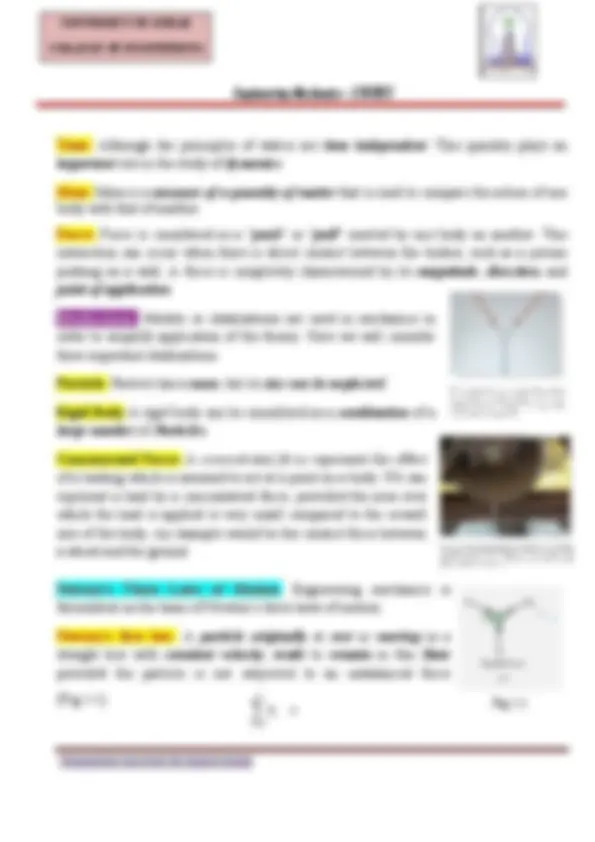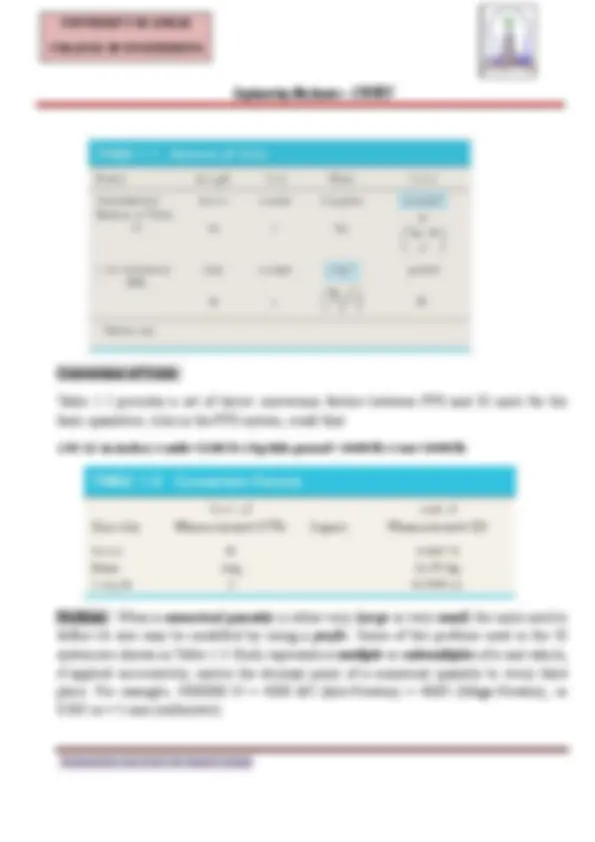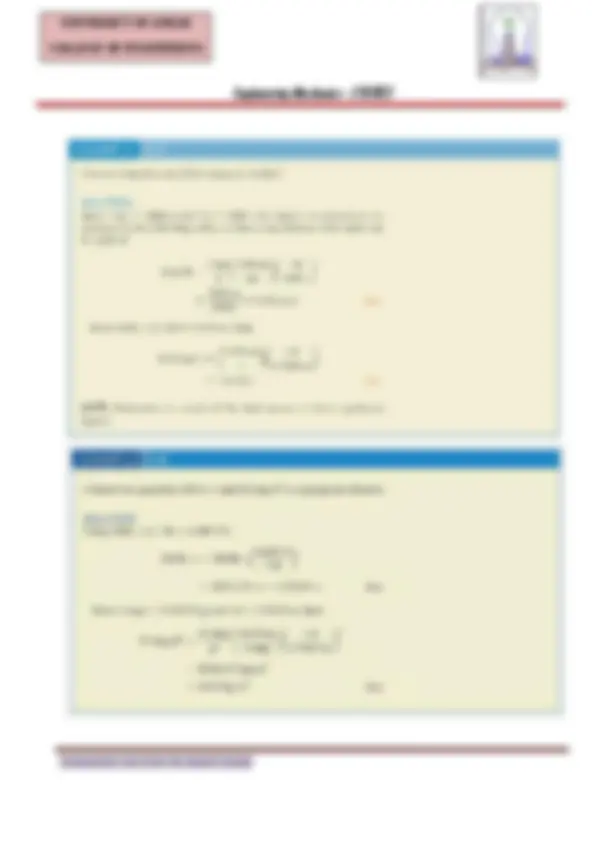








Study with the several resources on Docsity

Earn points by helping other students or get them with a premium plan


Prepare for your exams
Study with the several resources on Docsity

Earn points to download
Earn points by helping other students or get them with a premium plan
Community
Ask the community for help and clear up your study doubts
Discover the best universities in your country according to Docsity users
Free resources
Download our free guides on studying techniques, anxiety management strategies, and thesis advice from Docsity tutors
COLLEGE OF ENGINEERING. Engineering Mechanics - STATICS. Prepared by : Ass. Prof. Dr. Ayad A. Sulaibi. Textbook. • R. C. Hibbeler, "Engineering mechanics ...
Typology: Slides
1 / 12

This page cannot be seen from the preview
Don't miss anything!







Lecture Notes Prepared by:
Assistant Professor Dr. Ayad A. Sulaibi
COLLEGE OF ENGINEERING
Engineering Mechanics - STATICS
Prepared by : Ass. Prof. Dr. Ayad A. Sulaibi
To understand and use the general ideas of force vectors and equilibrium of particle and rigid body. To understand and use the general ideas of structural analysis and internal force and friction. To understand and use the general ideas of center of gravity, centroids and moments of inertia.
**1. General principles
COLLEGE OF ENGINEERING
Engineering Mechanics - STATICS
Prepared by : Ass. Prof. Dr. Ayad A. Sulaibi
CHAPTER 1
Mechanics is a branch of the physical sciences that is concerned with the state of rest or motion of bodies that are subjected to the action of forces. In general, this subject can be subdivided into three branches: rigid-body mechanics, deformable-body mechanics , and fluid mechanics.
The subject of statics developed very early in history because it’s principles can be formulated simply from measurements of geometry and force. Statics deals with the equilibrium of bodies, that is, those that are either at rest or move with a constant velocity; whereas dynamics is concerned with the accelerated motion of bodies. We can consider statics as a special case of dynamics, in which the acceleration is zero; however, statics deserves separate treatment in engineering education since many objects are designed with the intention that they remain in equilibrium.. 1.2 Basic Concepts Before we begin our study of engineering mechanics, it is important to understand the meaning of certain fundamental concepts and principles.
Length: Length is used to locate the position of a point in space and thereby describe the size of a physical system. Once a standard unit of length is defined, one can then use it to define distances and geometric properties of a body as multiples of this unit.
CHAPTER OBJECTIVES To provide an introduction to the basic quantities and idealizations of mechanics. To give a statement of Newton ’ s Laws of Motion and Gravitation. To review the principles for applying the SI system of units. To examine the standard procedures for performing numerical calculations. To present a general guide for solving problems.
COLLEGE OF ENGINEERING
Prepared by : Ass. Prof. Dr. Ayad A. Sulaibi
Time: Although the principles of statics are important role in the study of
Mass: Mass is a measure of a quantity of matter body with that of another. Force: Force is considered as a " interaction can occur when there is direct contact between the bodies, such as a person pushing on a wall. A force is completely characterized by its point of application.
Idealizations: Models or idealizations are used in mechanics in order to simplify application of the theory. Here we will consider three important idealizations.
Particle: Particle has a mass
Rigid Body A rigid body can be considered as a large number of Particles.
Concentrated Force: A concentrated force of a loading which is assumed to act at a point on a body. We can represent a load by a concentrated force, provided the area over which the load is applied is very small compared to the overall size of the body. An example a wheel and the ground.
Newton’s Three Laws of Motion formulated on the basis of Newton’s three laws of motion
Newton’s first law: A particle originally straight line with constant velocity provided the particle is not subjected to an unbalanced force (Fig.1-1).
Engineering Mechanics - STATICS
Prepared by : Ass. Prof. Dr. Ayad A. Sulaibi
Although the principles of statics are time independent. This quantity plays an role in the study of dynamics.
measure of a quantity of matter that is used to compare
Force is considered as a " push " or " pull " exerted by one body on another. This interaction can occur when there is direct contact between the bodies, such as a person pushing on a wall. A force is completely characterized by its magnitude
ls or idealizations are used in mechanics in order to simplify application of the theory. Here we will consider important idealizations.
mass , but its size can be neglected.
A rigid body can be considered as a combination of a
concentrated force represents the effect loading which is assumed to act at a point on a body. We can load by a concentrated force, provided the area over applied is very small compared to the overall size of the body. An example would be the contact force between
Newton’s Three Laws of Motion: Engineering mechanics is formulated on the basis of Newton’s three laws of motion.
particle originally at rest or moving in a constant velocity , tends to remain in this State provided the particle is not subjected to an unbalanced force
. This quantity plays an
to compare the action of one
" exerted by one body on another. This interaction can occur when there is direct contact between the bodies, such as a person magnitude , direction , and
ls or idealizations are used in mechanics in order to simplify application of the theory. Here we will consider
of a
Engineering mechanics is
in a State provided the particle is not subjected to an unbalanced force
Fig 1-
COLLEGE OF ENGINEERING
Engineering Mechanics - STATICS
Prepared by : Ass. Prof. Dr. Ayad A. Sulaibi
Fig 1-
m 1 , m 2 : mass of each of the two particles. r : distance between the two particles.
Weight: Weight refers to the gravitational attraction of the earth on a body or quantity of mass. The weight of a particle having a mass is stated mathematically. � = �� …….. (1.3)
Measurements give: g = 9.8066 �/�� Therefore, a body of mass 1 kg has a weight of 9.81 N , a 2 kg body weights 19.62 N, and so on (Fig. 1-4).
Units of Measurement:
SI units: The international System of units. Abbreviated SI is a modern version which has received worldwide recognition. As shown in Tab 1.1. The SI system defines length in meters (m) , time in seconds (s) , and mass in kilograms (kg). In the SI system the unit of force, the Newton is a derived unit. Thus, 1 Newton ( N ) is equal to a force required to give 1 kilogram of mass and acceleration of 1 �/�^2. US customary: In the U.S. Customary system of units ( FPS ) length is measured in feet (ft) , time in seconds (s) , and force in pounds (lb). The unit of mass , called a slug , 1 slug is equal to the amount of matter accelerated at 1 ��/� �^ when acted upon by a force of 1 lb (1 ����=1 �� �^2 /��). Therefore, if the measurements are made at the “standard location,” where g = 32.2 ft/s 2 , then from Eq. 1.3 , m = W / g ( g = 32.2 ft/s^2 ) …….(1.4) And so a body weighing 32.2 lb has a mass of 1 slug, a 64.4-lb body has a mass of 2 slugs, and so on.
COLLEGE OF ENGINEERING
Prepared by : Ass. Prof. Dr. Ayad A. Sulaibi
Conversion of Units:
Table 1.2 provides a set of direct conversion factors between FPS and SI units for the basic quantities. Also in the FPS system, recall that: � ��=�� �� ������ � ����=���
Prefixes: When a numerical quantity define its size may be modified by using a system are shown in Table 1.3. Each represents a if applied successively, moves the decimal point of a numerical quantity to every third place. For example, 4000000 0.005 m = 5 mm (millimeter
Engineering Mechanics - STATICS
Prepared by : Ass. Prof. Dr. Ayad A. Sulaibi
Table 1.2 provides a set of direct conversion factors between FPS and SI units for the basic quantities. Also in the FPS system, recall that: �� �� � �� ���� ����� =���� �� � ���=��
numerical quantity is either very Large or very define its size may be modified by using a prefix. Some of the prefixes used in the SI system are shown in Table 1.3. Each represents a multiple or submultiples if applied successively, moves the decimal point of a numerical quantity to every third place. For example, 4000000 N = 4000 kN (kilo-Newton) = 4MN ( millimeter).
Table 1.2 provides a set of direct conversion factors between FPS and SI units for the
��� ��
or very small , the units used to
. Some of the prefixes used in the SI submultiples of a unit which, if applied successively, moves the decimal point of a numerical quantity to every third 4MN (Mega-Newton), or
COLLEGE OF ENGINEERING
Prepared by : Ass. Prof. Dr. Ayad A. Sulaibi
Engineering Mechanics - STATICS
Prepared by : Ass. Prof. Dr. Ayad A. Sulaibi
COLLEGE OF ENGINEERING
Engineering Mechanics - STATICS
Prepared by : Ass. Prof. Dr. Ayad A. Sulaibi